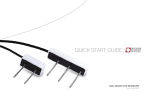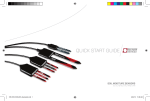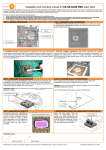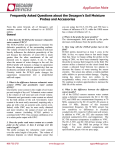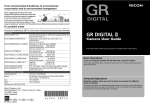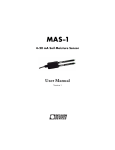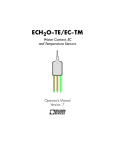Download Manual-EC-5-sensor-E..
Transcript
EC-5 Soil Moisture Sensor User’s Manual Version 1 Decagon Devices, Inc. 2365 NE Hopkins Court Pullman WA 99163 USA (509) 332-5600 Trademarks: “ECH2O” is a registered trademark of Decagon, Devices, Inc All rights reserved.. ©2001-2012 Decagon Devices, Inc. All rights reserved. EC-5 User’s Manual Table of Contents Contents 1. Introduction . . . . . . . . . . . . . . . . .1 EC-5 Specifications . . . . . . . . . . . . . . . . . . Customer Support . . . . . . . . . . . . . . . . . . . Warranty Information . . . . . . . . . . . . . . . Seller’s Liability . . . . . . . . . . . . . . . . . . . . . 1 2 2 2 2. About the EC-5 . . . . . . . . . . . . . . .4 Sensor Features . . . . . . . . . . . . . . . . . . . . . 4 Wiring Diagrams . . . . . . . . . . . . . . . . . . . . 5 3.5mm Plug Wiring . . . . . . . . . . . . . . . 5 Wiring to Non-Decagon Data Loggers 5 Extended cable lengths . . . . . . . . . . . . . . . 6 3. Installing the Sensors . . . . . . . . . .7 Procedure . . . . . . . . . . . . . . . . . . . . . . . . . . 7 Orientation . . . . . . . . . . . . . . . . . . . . . . 8 Removing the Sensor . . . . . . . . . . . . . . 8 4. Collecting Data . . . . . . . . . . . . . . .9 Data Logger Requirements . . . . . . . . . . . . 9 Connecting to a Data Logger . . . . . . . . . 10 Sample Program . . . . . . . . . . . . . . . . . . . 10 SCWin (Short Cut) Directions . . . . . . . . 11 Calibration . . . . . . . . . . . . . . . . . . . . . . . . 13 Sensor Calibration Values . . . . . . . . . 13 Troubleshooting . . . . . . . . . . . . . . . . . . . . 16 Declaration of Conformity . . . . . .17 Index . . . . . . . . . . . . . . . . . . . . . . . .19 i EC-5 User’s Manual Table of Contents ii EC-5 User’s Manual 1. Introduction 1. Introduction EC-5 Specifications Measurement Time: 10ms (milliseconds) Accuracy: at least 0.03 m3/m3 all soils, up to 8 dS/m With soil-specific calibration: ±.02 m3/m3 (±2%) Resolution: 0.001 m3/m3 VWC in mineral soils, 0.25% in growing media Power Requirements: 2.5VDC - 3.6VDC @ 10mA Output: 10-40% of excitation voltage (250-1000mV at 2500mV excitation) Operating Environment: -40 to +60 °C Range of Measurement: 0 to saturation Sensor dimensions: 8.9cm x 1.8cm x 0.7cm Cable length: 5m standard, custom lengths or extension cables are available Connector types: 3.5 mm plug or stripped and tinned lead wires Data Logger Compatibility (not exclusive): Decagon: Em5b, Em50 series loggers Campbell Scientific: CR10X, 21X, 23X, CR1000, CR3000, etc. 1 EC-5 User’s Manual 1. Introduction Customer Support If you ever need assistance with your EC-5, or if you just have questions or feedback, there are several ways to contact us. Customer service representatives are available to speak with you Monday thru Friday, between 8am and 5pm Pacific time. Phone: 1-509-332-5600 Fax: 1-509-332-5158 E-mail: [email protected] or [email protected] If contacting us by email or fax, please include as part of your message your name, address, phone, and fax number along with a description of your problem. NOTE: If you purchased your EC-5 through a distributor, please contact them for assistance. Warranty Information The EC-5 has a 30-day satisfaction guarantee and a oneyear warranty. 2 EC-5 User’s Manual 1. Introduction Seller’s Liability Seller warrants new equipment of its own manufacture against defective workmanship and materials for a period of one year from date of receipt of equipment (the results of ordinary wear and tear, neglect, misuse, accident and excessive deterioration due to corrosion from any cause are not to be considered a defect); but Seller’s liability for defective parts shall in no event exceed the furnishing of replacement parts F.O.B. the factory where originally manufactured. Material and equipment covered hereby which is not manufactured by Seller shall be covered only by the warranty of its manufacturer. Seller shall not be liable to Buyer for loss, damage or injuries to persons (including death), or to property or things of whatsoever kind (including, but not without limitation, loss of anticipated profits), occasioned by or arising out of the installation, operation, use, misuse, nonuse, repair, or replacement of said material and equipment, or out of the use of any method or process for which the same may be employed. The use of this equipment constitutes Buyer’s acceptance of the terms set forth in this warranty. There are no understandings, representations, or warranties of any kind, express, implied, statutory or otherwise (including, but without limitation, the implied warranties of merchantability and fitness for a particular purpose), not expressly set forth herein. 3 EC-5 User’s Manual 2. About the EC-5 2. About the EC-5 The two-prong design and higher measurement frequency allows the EC-5 to measure VWC from 0 to 100% (VWC of saturated soils is generally 40-60% depending on the soil type) and allows accurate measurement of all soils and soilless medias with a wide range of salinities. Sensor Features Circuitry Sensor Fig. 1: EC-5 diagram 4 EC-5 User’s Manual 2. About the EC-5 Wiring Diagrams 3.5mm Plug Wiring The EC-5 comes with a 3.5mm “stereo plug” connector. This allows for rapid connection directly to Decagon’s Em50 and Em5 loggers and the ProCheck. Below is a diagram showing the wiring configuration for this connector. Analog out Ground Excitation Fig. 2: 3.5mm “Stereo Plug” wiring configuration Wiring to Non-Decagon Data Loggers Models with stripped and tinned leads are pre-configured for connecting to non-Decagon data loggers. Simply wire the lead into the data logger as described in “Connecting to a Data Logger” in Chapter 4. If your model uses the standard 3.5mm plug, you have two choices when attaching the sensor to non-Decagon data loggers. First, you can clip off the plug on the sensor cable, strip and tin the wires, and wire it directly into the data logger. This has the advantage of creating a direct connection with no chance of the sensor becoming un-plugged; however, it then cannot be used in the future with a Decagon Em50 or Em5 logger. The other 5 EC-5 User’s Manual 2. About the EC-5 choice is to obtain an adapter cable from Decagon. The 3-wire sensor adapter cable has a connector for the sensor jack on one end, and three wires on the other end for connection to a data logger (this type of wire is often referred to as a “pigtail” adapter). Both the sensor wire and adapter cable wire have the same wire output (shown in Fig. 3); the white wire is excitation, red is output, and the bare wire is ground. Analog out (Red) Ground (Bare) Sensor cable Excitation (White) Fig. 3: 3-wire cable wiring configuration Extended cable lengths Decagon recommends that you purchase customized cable lengths if your project requires longer cable leads. Custom cable lengths may be requested with a 3.5mm connector or stripped & tinned end. 6 EC-5 User’s Manual 3. Installing the Sensors 3. Installing the Sensors When selecting a site for installation, it is important to remember that the soil adjacent to the sensor surface has the strongest influence on the sensor reading and that the sensor measures the volumetric water content. Therefore any air gaps or excessive soil compaction around the sensor can profoundly influence the readings. Also, do not install the sensors adjacent to large metal objects such as metal poles or stakes. This can attenuate the sensor’s electromagnetic field and adversely affect output readings. Because the EC-5 has gaps between its prongs, it is also important to consider the size of the media you are inserting the sensor into. It is possible to get sticks, bark, roots or other material stuck between the sensor prongs, which will adversely affect readings. Finally, be careful when inserting the sensors into dense soil, as the prongs will break if excessive sideways force is used when pushing them in. Procedure When installing the EC-5, it is best to maximize contact between the sensor and the soil. 1. The EC-5 sensor was designed for easy installation into the soil. After digging a hole to the desired depth, push the prongs on the sensor into undisturbed soil at the bottom of the hole or into the sidewall of the hole. Make sure that the prongs and black overmolding are buried completely as shown below. 7 EC-5 User’s Manual 3. Installing the Sensors The sensor may be difficult to insert into extremely compact or dry soil. If you have difficulty inserting the sensor, try loosening the soil somewhat or wetting the soil. Never pound it in! 2. Carefully backfill the hole to match the bulk density of the surrounding soil. Be careful not to bend the black overmolding connecting the sensor to the cable. To watch a video on proper installation of the sensor go to www.decagon.com/install. Orientation The sensor can be oriented in any direction. However, orienting the flat side perpendicular to the surface of the soil will minimize effects on downward water movement. Removing the Sensor When removing the sensor from the soil, do not pull it out of the soil by the cable! Doing so may break internal connections and make the sensor unusable. 8 EC-5 User’s Manual 4. Collecting Data 4. Collecting Data Data Logger Requirements The EC-5 sensor is designed to work most efficiently with Decagon’s 5-channel Em5b, Em50, or ProCheck handheld readout. All Decagon readout devices use a 3.0V excitation. The sensors however, may be adapted for use with other data loggers, such as those from Campbell Scientific, Inc., for example. The EC-5 requires an excitation voltage in the range of 2 to 3.6 volts. The sensors produce an output voltage that depends on the dielectric constant of the medium surrounding the sensor, and ranges between 10 and 50% of the excitation voltage. Any data logger which can produce a 2.5 to 3.6V excitation with approximately 10 millisecond duration and read a voltlevel signal with 12-bit or better resolution should be compatible with the EC-5 sensor. The current requirement for the EC-5 is 10mA at 2.5V. NOTE: EC-5 sensors are intended only for use with data loggers and readout devices which can provide short excitation pulses, leaving the sensors turned off most of the time. Continuous excitation not only wastes battery power, but may, under certain circumstances, cause the sensor to exceed government specified limits on electromagnetic emissions. Do not continuously power the EC-5 sensor. 9 EC-5 User’s Manual 4. Collecting Data Connecting to a Data Logger Connect the wires to the data logger as shown, with the supply wire (white) connected to the excitation, the analog out wire (red) to an analog input, and the bare ground wire to ground: Analog Supply Analog out Supply Ground out Exc. Exc. Ground L H H Analog a In og L G G Data Logger Data Logger Fig. 5: Data logger configuration Sample Program The following program is an example that can be used with Campbell Scientific’s CR10X data logger and our EC-5 sensor at a 2500mV excitation: ;{CR10X} ; Example ECH2O Data Logger Program for CR10X ; Wiring: ; White: Excitation Channel 1 ; Red: Input Single Ended Channel 1 ; Black: Ground *Table 1 Program 10 EC-5 User’s Manual 4. Collecting Data 01: 1 Execution Interval (seconds) ; Factory calibration equations for ECH2O ; probes convert mV output of ECH2O to ; volumetric water content (VWC, m3/m3) ; EC-5: VWC = 0.00119 * mV - 0.400 1: Excite-Delay (SE) (P4) 1: 1 Reps 2: 5 2500 mV Slow Range 3: 1 SE Channel 4: 1 Excite all reps w/Exchan 1 5: 1 Delay (0.01 sec units) 6: 2500 mV Excitation 7: 1 Loc [ Probe_VWC ] 8: .00119 Multiplier 9: -.4 Offset *Table 2 Program 02: 0.0000 Execution Interval (seconds) *Table 3 Subroutines End Program SCWin (Short Cut) Directions The following are instructions for using Campbell Scientific’s SCWin (Short Cut) program to read the EC-5 soil moisture sensor. 1. Download EchoCSI.zip from http://www.decagon.com/appnotes/EchoCSIappnote.pdf. 2. Unzip the folder EchoCSI.zip. 3. Locate the file containing SCWin.exe. It should be in C:\Program Files\Campbellsci\SCWin. Place the 11 EC-5 User’s Manual 4. Collecting Data following files from the unzipped EchoCSI.zip folder into the folder with SCWin.exe: AM1632Z.MUX AM416Z.MUX EC10.SCS EC101632.SCS EC10416.SCS EC20.SCS EC201632.SCS EC20416.SCS EC5.SCS EC5632.SCS EC5416.SCS SCWIN-DECAGON.CNT SCWIN-DECAGON.HLP Note: If you are not able to find this directory path, search for the folder that contains SCWIN.exe and place the files into that folder. 4. Open up SCWin.exe (Short Cut). If you are using a V.3 copy of LoggerNet, there is a tab for SCWin (Short Cut) on the tool bar. 5. Select “New” to start a new program to read the EC-5. a. Select the data logger you will be using to read the sensors. b. Select the measurement interval (a shorter measurement interval, i.e. 1 sec., is sometimes desirable when testing the sensor). 6. Click on Sensors (this should open a new page with a file tree on it). 12 EC-5 User’s Manual 4. Collecting Data 7. Under the “Sensors” file tree, double-click on “Meteorological” and then select “Soil Moisture.” 8. Choose “EC-5” Sensor. Calibration Decagon’s ECH2O Utility, and DataTrac3 automatically apply factory calibrations to the sensors’ output data. However, this general calibration may not be applicable for all soil types. For added accuracy we encourage our customers to perform soil-specific calibrations. The calibration equation that you will use depends on where you will be using it. If you will be using it with sensors connected to a non-Decagon data logger you will need to use the 2500 mV calibration. If you use any Decagon software (DataTrac3, ECH2O Utility, etc.) or the user calibration menu in the ProCheck, you will need to use the RAW calibration. The difference between the two is the slope constant. To increase the resolution of the sensor output, Decagon uses all available increments of the 12-bit number (value of 4096) where the measurement is stored. Thus, the output of the sensors read by the ProCheck and Decagon loggers must be multiplied by 0.61 AND the 2500 mV slope to give the right value. Sensor Calibration Values Following is a list of the both the millivolt and RAW calibration values for the EC-5, where is the volumetric water content, mV is the millivolt output of the sensor, and where x is the RAW sensor output. 13 EC-5 User’s Manual 4. Collecting Data The EC-5 is much less sensitive to variation in texture and electrical conductivity because it runs at a much higher measurement frequency. Therefore, its general calibration equation should apply for all mineral soils up to 8 dS/m saturation extract. Its calibration equations are shown below for mineral soil, potting soil, and rockwool growing media: Dielectric Permittivity Dielectric permittivity can be used to determine volumetric water content using external published equations such as the Topp equation. Dielectric permittivity is given by = 1/(-1.x 10-9RAW3 x 10-6 RAW2x 10-3 RAW where RAW is the output from the Decagon data logger using 3V excitation. If you are using a non-Decagon data logger, dielectric permittivity is given by = 1/(x 10-9mV3 x 10-6mV2 x 10-3 mV Mineral Soils According to our tests, a single calibration equation will generally suffice for all mineral soil types with electrical conductivities from 0.1 dS/m to 10 dS/m saturation extract. Volumetric water content (ø) is given by ø = 8.5 * 10-4 * RAW - 0.48 (1) 14 EC-5 User’s Manual 4. Collecting Data where RAW is the output from the Decagon data logger using 3V excitation. If you are using a non-Decagon data logger, VWC is given by ø = 11.9 * 10-4 * mV - 0.401 (2) where mV is the output of the sensor when excited at 2500 mV. Please note that the equation will reach a maximum at ~60% volumetric water content (VWC) in pure water. To display data on a scale from 0 to 100%, VWC should be modeled with a quadratic equation (which would result in a 100% VWC in water), but a linear equation fits the mineral soil VWC range as well as the quadratic, and linear equations are easier to deal with, especially since mineral soil typically saturates at ~40 - 50% VWC. Potting soil The following equations can be used to convert EC-5 output to water content in potting soil. We tested several types of potting soil (Sunshine mix, Miracle Grow Potting Mix, and Custom Nursery soil) at several salinities and found that VWC is given by ø = 1.3 * 10-3 * RAW - 0.696 (3) for a Decagon data logger or ø = 2.11 * 10-3 * mV - 0.675 (4) for a data logger with 2500mV excitation. 15 EC-5 User’s Manual 4. Collecting Data Rockwool The EC-5 was calibrated in Grodan Master rockwool with solution electrical conductivities of 0.2, 1.0, 1.5, 2.0, and 4.5 dS/m. Volumetric water content can be calculated using ø = 6.28 * 10-7 * RAW2 + 1.37 x 10-4 * RAW - 0.183(5) for a Decagon data logger or ø = 2.63 * 10-6 * mV2 + 5.07 x 10-4 * mV - 0.0394(6) for a data logger with 2500 mV excitation. NOTE: These calibration constants only apply to 2500mV excitations; use of these numbers with any other excitation voltage will result in erroneous readings! Troubleshooting If you encounter problems with the EC-5, they most likely will manifest themselves in the form of incorrect or erroneous readings. Before contacting Decagon about the sensor, do the following: • Check to make sure the connections to the data logger are both correct and secure. • Ensure that your data logger’s batteries are not dead or weakened. If you encounter problems that aren’t due to the data logger, please contact Decagon at (509) 332-5600 or at [email protected]. 16 EC-5 User’s Manual Declaration of Conformity Declaration of Conformity Application of Council Directive: Standards to which conformity is declared: Manufacturer’s Name: 89/336/EE6 EN61326 : 1998 EN51022 : 1998 Decagon Devices, Inc. 2365 NE Hopkins Court Pullman, WA 99163 USA Type of Equipment: Soil moisture sensor Model Number: EC-5 Year of First Manufacture: 2001 This is to certify that the EC-5 ECH2O soil moisture sensor, manufactured by Decagon Devices, Inc., a corporation based in Pullman, Washington, USA meets or exceeds the standards for CE compliance as per the Council Directives noted above. All instruments are built at the factory at Decagon and pertinent testing documentation is freely available for verification. 17 EC-5 User’s Manual Declaration of Conformity 18 EC-5 User’s Manual Index Index A Accuracy 1 C Calibration 13 for mineral soil 14 for potting soil 15 for rockwool 16 Customer support 2 D Data logger 1 connecting to 10 requirements 9 sample program 10 Declaration of conformity 17 Dielectric permittivity 14 E E-mail 2 Extension cables 6 F Fax 2 I Installation 7 M Measurement range 1 Mineral soil calibration 14 19 EC-5 User’s Manual Index O Orientation of sensor 8 P Phone number 2 Plug wiring configuration 5 Potting soil 15 Power requirements 1 Program 10 R Range 1 Removing sensor 8 Rockwool 16 S Seller’s liability 2 Sensor calibration 13 installation instructions 7 orientation 8 specifications 1 Short cut directions 11 Specifications 1 T Troubleshooting 16 W Warranty 2 Wiring diagrams 5 20





























